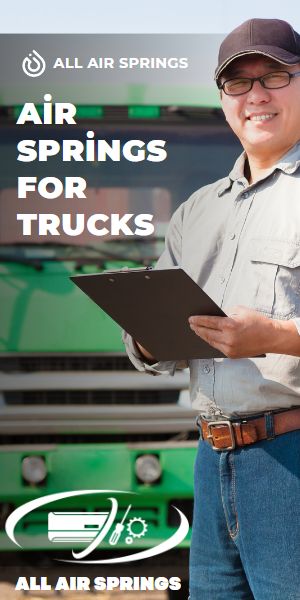Everything You Need to Know About Adjustable Cabin Air Springs: Benefits, Installation, and More
Introduction to Adjustable Cabin Air Springs
Adjustable cabin air springs are an innovative solution designed to enhance the comfort, performance, and overall ride quality of vehicles. Unlike traditional metal coil springs or leaf springs, these air springs use compressed air to provide a smooth, adjustable suspension system. The key benefit of adjustable cabin air springs is their ability to change the suspension height and stiffness according to the vehicle’s load and driving conditions. This makes them a popular choice for both passenger vehicles and heavy-duty trucks, offering a customizable ride experience that adapts to various terrains and weight loads.
The demand for adjustable cabin air springs has grown as consumers seek more comfort, especially in vehicles used for long drives or hauling heavy loads. With their ability to absorb shocks and reduce vibrations, these air springs significantly improve driving comfort. Additionally, the adjustable nature of these springs allows for better handling and stability, ensuring that the vehicle performs optimally in various conditions. In this chapter, we will explore the fundamentals of adjustable cabin air springs and why they are becoming an essential feature in modern vehicles.
What Are Adjustable Cabin Air Springs?
Adjustable cabin air springs are specialized suspension components that replace traditional coil or leaf springs in vehicles. These air springs use a flexible rubber airbag filled with pressurized air to absorb shock and support the weight of the vehicle. The most notable feature of adjustable cabin air springs is their ability to change the air pressure inside the airbag, allowing the suspension height and stiffness to be modified based on the vehicle’s load or driving conditions.
Unlike traditional springs, which provide a fixed amount of resistance, air springs can be adjusted to offer a tailored level of support. By increasing the air pressure, the springs become firmer, providing better load support and ride height. Conversely, decreasing the air pressure softens the suspension, offering a more comfortable ride, especially over rough or uneven terrain.
The system typically includes an air compressor, air tank, and control valves, all working together to maintain the desired air pressure. This adjustment can be done manually or automatically, depending on the vehicle’s setup. These springs are often found in heavy-duty trucks, RVs, and luxury passenger vehicles, where versatility and comfort are key priorities. The adjustable nature of these springs allows for a smoother, more stable ride in various conditions, making them a popular choice for modern suspension systems.
Benefits of Adjustable Cabin Air Springs
Adjustable cabin air springs offer a range of benefits that enhance both the comfort and performance of a vehicle. One of the most significant advantages is the improved ride quality. Air springs absorb shock more effectively than traditional metal springs, resulting in a smoother, more comfortable ride, particularly on rough roads or uneven terrains. The ability to adjust the air pressure allows drivers to tailor the suspension to their preferences or to accommodate various driving conditions, ensuring optimal comfort at all times.
Another key benefit of adjustable air springs is their enhanced load-handling capabilities. Whether you’re carrying heavy cargo or towing a trailer, the suspension can be adjusted to compensate for the added weight, preventing the vehicle from sagging or becoming unstable. This improves overall vehicle stability, safety, and handling, especially when the load shifts during turns or stops.
In addition to performance benefits, adjustable cabin air springs can also reduce long-term maintenance costs. Traditional suspension systems can wear out more quickly, requiring frequent repairs or replacements. Air springs, however, are less prone to wear and tear, and their adjustable nature helps extend their lifespan by preventing overloading. Overall, these air springs provide a versatile and cost-effective solution for improving both comfort and durability in various vehicle applications.
How Adjustable Cabin Air Springs Work
Adjustable cabin air springs operate based on the principle of air pressure to control the vehicle’s suspension height and stiffness. The core component of this system is the airbag, which is typically made from a flexible, durable rubber material. This airbag is filled with compressed air that acts as the cushioning element in the suspension system.
To adjust the ride quality, the air pressure inside the airbag can be increased or decreased. When more air is added, the spring becomes firmer, raising the vehicle’s ride height and providing additional support for heavier loads. On the other hand, reducing the air pressure softens the suspension, allowing for a smoother ride, especially when the vehicle is lightly loaded or traveling on rough roads.
The air pressure is controlled through a system of valves, an air compressor, and an onboard control unit. Some systems allow for manual adjustment via a switch, while others feature automatic air pressure regulation. In an automatic system, sensors continuously monitor factors such as the vehicle’s load, ride height, and road conditions. The control unit then adjusts the air pressure accordingly, ensuring optimal ride quality without the need for driver intervention.
This flexible adjustment makes air springs particularly advantageous for vehicles that need to adapt to varying conditions, such as heavy-duty trucks, recreational vehicles (RVs), and luxury cars, providing both superior comfort and handling in diverse environments.
Applications of Adjustable Cabin Air Springs
Adjustable cabin air springs are highly versatile and can be found in a variety of vehicle applications, enhancing comfort and performance across different use cases. One of the most common applications is in
passenger vehicles
, particularly luxury cars and SUVs. These vehicles benefit from the adjustable nature of air springs, as they provide a smooth ride and can adapt to different road conditions, whether it’s smooth highways or uneven city streets.
Heavy-duty trucks and commercial vehicles also rely on adjustable cabin air springs. These vehicles often carry heavy loads or tow trailers, and the ability to adjust the suspension according to the weight ensures a stable and secure ride. By modifying the air pressure, these trucks maintain better control and comfort, reducing wear and tear on both the vehicle and its cargo.
Another key application is in recreational vehicles (RVs) and camper vans. Since these vehicles are used for long-distance travel and may encounter a variety of terrains, adjustable air springs are essential for maintaining comfort and safety. The ability to adjust the suspension allows RV owners to ensure the vehicle stays level, even when parked on uneven surfaces, and helps in towing heavier loads such as trailers or boats.
In addition, vans and buses used for passenger transport can benefit from adjustable cabin air springs, providing a more comfortable and stable ride for passengers. Overall, the flexibility of adjustable air springs makes them an ideal solution for a wide range of vehicles that demand comfort, performance, and adaptability.
Choosing the Right Adjustable Cabin Air Springs
Selecting the right adjustable cabin air springs is crucial for ensuring optimal performance, comfort, and durability for your vehicle. Several factors must be considered to make an informed decision, including the type of vehicle, the typical load it carries, and the driving conditions it regularly encounters.
First, consider the
weight capacity
of the air springs. Different air springs are designed to handle varying levels of weight, so it’s important to choose a model that matches the load your vehicle will frequently carry. If you drive a heavy-duty truck or towing vehicle, look for air springs with higher weight ratings to provide the necessary support without compromising ride quality.
Another critical factor is adjustability. Some air springs offer a wide range of adjustments, allowing you to fine-tune the suspension for both comfort and load handling. If your vehicle encounters different terrains or varies in load, choosing a system with a broad adjustability range will offer more versatility.
The ease of installation is also an important consideration. Some air springs are designed for DIY installation, while others may require professional help. Depending on your technical skill and comfort level, choose a system that matches your needs. Many modern systems also include automatic air pressure regulation, making them more convenient and requiring less manual intervention.
Finally, focus on durability and quality. Look for air springs made from high-quality, durable materials that can withstand wear and tear over time. Research trusted brands that are known for their reliability and long-lasting performance. By considering these factors, you can select the perfect adjustable cabin air springs for your vehicle, ensuring improved ride comfort and stability.
Installation and Maintenance Tips
Installing and maintaining adjustable cabin air springs properly is key to maximizing their performance and lifespan. Whether you’re considering a DIY installation or opting for professional help, understanding the steps and regular maintenance requirements will ensure your air springs continue to function optimally.
Installation Tips:
-
Professional vs. DIY Installation
: While some adjustable air spring systems are designed for DIY installation, others may require professional expertise. Ensure that you have the right tools and experience if you plan to install them yourself. Incorrect installation can lead to issues such as improper air pressure regulation or uneven suspension.
-
Check Compatibility: Before purchasing, verify that the air springs are compatible with your vehicle model. Consult the manufacturer’s guidelines or speak to an expert to ensure you’re choosing the correct type for your vehicle’s suspension system.
-
Follow Manufacturer Instructions: Always follow the installation manual provided by the manufacturer. Pay close attention to detailed instructions for air compressor setup, valve connections, and airbag placement. This will help avoid installation errors that could affect performance.
Maintenance Tips:
-
Check Air Pressure Regularly: Monitoring air pressure is essential for maintaining comfort and performance. If the air pressure becomes too low or too high, it can affect the ride quality. Use a pressure gauge to check the pressure regularly and adjust as needed.
-
Inspect for Leaks: Air leaks are a common issue with air springs. Periodically inspect the system for any signs of damage or air loss, particularly around connections and the airbag itself. If you detect a leak, it’s important to repair it immediately to prevent further damage.
-
Maintain the Compressor: The air compressor is a vital component of the system, and it should be kept in good working condition. Regularly inspect the compressor for any issues, and clean it to prevent dirt buildup that could impair performance.
-
Clean the Air Springs: Clean the rubber air springs regularly to remove dirt, debris, and road salt, which can cause wear. Avoid using harsh chemicals that could damage the rubber.
By following these installation and maintenance tips, you can ensure that your adjustable cabin air springs provide reliable performance, enhancing the overall comfort and handling of your vehicle.
Conclusion: The Future of Adjustable Cabin Air Springs
Adjustable cabin air springs represent a significant advancement in automotive suspension technology, offering unparalleled comfort, versatility, and load management. As vehicles continue to evolve and drivers demand more customization in their driving experience, the future of adjustable air springs looks promising. Innovations in air spring design and air pressure control systems are expected to make these systems even more efficient, user-friendly, and cost-effective.
In the coming years, we can anticipate greater integration of
smart technology
in adjustable cabin air springs. Systems that automatically adjust to road conditions, load, and driver preferences could become more prevalent, improving both convenience and safety. The integration of sensors, artificial intelligence, and more precise control units will allow for even smoother and more responsive suspension systems.
As more vehicles, from luxury cars to heavy-duty trucks and RVs, adopt adjustable cabin air springs, we will likely see a shift towards sustainability. Manufacturers may focus on creating more environmentally friendly materials and reducing the energy consumption of the air compressor and other components.
For vehicle owners, upgrading to adjustable cabin air springs is an investment that pays off in terms of comfort, performance, and vehicle longevity. Whether you’re navigating city streets or off-road terrain, adjustable air springs provide the adaptability needed for a smoother ride. With ongoing advancements, these suspension systems will continue to be an essential feature for drivers seeking an optimal, customizable driving experience.
For detailed information, you can contact us at torqueusa.com


